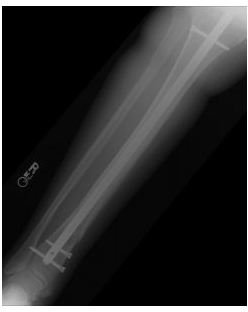Signs and Symptoms of Bone Cancer
Bone Cancer Information
Bone cancer is a rare type of cancer that begins in the bone. Bone cancer accounts for 1% of all cancers, affecting approximately 2,300 people in the United States every year. Cancerous tumors can form on any bone within the body, but are most common on long bones of the arms and legs. The malignant tumors destroy the normal bone tissue, weakening the bone. There are different types of bone cancer, each with different features. Bone cancer types are: osteosarcoma, chondrosarcoma, Ewing’s Sarcoma and malignant fibrous histiocytoma. Bone tumors can be detected with an x-ray, MRI or CT Scan. Bone cancer diagnosis will rely on biopsy and blood tests to determine if the tumor is malignant (cancerous) or benign (non-cancerous).
Primary Bone Cancer vs. Secondary Bone Cancer
The term “bone cancer” refers to malignant tumors that originated in the bone. Cancer that started in the bone is labeled primary bone cancer. Primary bone cancer can spread to other areas of the body. Cancer that originated somewhere else in the body, then metastasizes to the bone is referred to as secondary bone cancer. Signs and symptoms of bone cancer may vary depending upon which type of cancer infected the bone.
Symptoms of Primary Bone Cancer
Primary bone cancer, or bone cancer that originated in the bone, may have different signs and symptoms of bone cancer than the symptoms associated with secondary bone cancer. Signs and symptoms of primary bone cancer are:
- Bone pain
- Swelling and/or tenderness near the tumor site
- Weakened bones
- Weakened bones that lead to fracture
- Fatigue
- Unexplained weight loss
- Elevated levels of calcium in the blood stream
Bone pain is the most common symptom of bone cancer. In children with bone cancer, bone pain may be misdiagnosed as “growing pains”. Bone pain that is persistent and/or worsens over time should be taken seriously and reported to a doctor. In most cases, a simple x-ray can detect the presence of a bone tumor.
Symptoms of Secondary Bone Cancer
Secondary bone cancer is the result of cancer that originated elsewhere and metastasized to the bone. Symptoms of secondary bone cancer may be the same as the symptoms of primary bone cancer, but may also include symptoms of the original cancer that caused the bone cancer. For example, if the primary cancer was breast cancer (which then spreads to the bone), signs and symptoms of breast cancer may be experienced in addition to bone cancer symptoms.
General symptoms of cancer (that may apply to any type of cancer) are:
- Fever
- Fatigue
- Skin changes
- Change in bladder function and/or bowel movements
- Unusual bleeding or discharge
- Indigestion
- Persistent cough
- Sores that do not heal
- Pain
What to Do if Experiencing Signs and Symptoms of Bone Cancer
If you or a loved one are experiencing any signs and symptoms of bone cancer you should consult your physician immediately. Primary bone cancer can metastasize to other areas of the body if left untreated. Early detection and treatment of bone cancer is important.
Sources Cited
“Bone Cancer: Questions and Answers.” National Cancer Institute
“Bone Cancer.” Mayo Clinic
“Signs and Symptoms of Cancer.” American Cancer Society
“Symptoms of Bone Cancer.” BoneCancerSymptoms.org
Photo Credit: © sxc.hu/TsuDhoNimh
